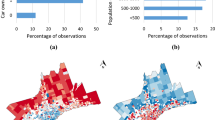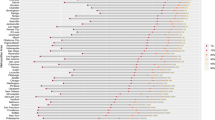Abstract
Accessibility measures reflect the level of service provided by transportation systems to various locations. Basic transportation choice behavior is defined to include those decisions of how many automobiles to own and how many trips to which destinations to make by automobile and by public transit. Here, these decisions are assumed to be made jointly by urban households and are conditional upon residential location decisions. It is the purpose of this paper to explore the role of accessibility as a causal factor in such basic transportation choice behavior.
An economic utility theory model of choice behavior is postulated in which the benefits from making trips to specific destinations are reflected by measures of destination attraction. Through determination of utility-maximizing trip frequencies, indirect utility functions are developed which include accessibility concepts. Behavioral implications of these concepts are proposed and contrasts are drawn to accessibility measures used in conventional segregated models of trip distribution, modal choice, and automobile ownership.
Sensitivity analyses of alternative empirical definitions of accessibility in the choice model are conducted using data from the Detroit Regional Transportation and Land Use Study — covering counties in southeastern Michigan. These analyses employ a multinomial logit estimation technique and focus on definitions of trip attraction. Results of these analyses indicate that more complicated attraction measures can be replaced by measures involving the proportion of either urban area population or urban area employment within a traffic analysis zone. Also, evidence is found that decision-makers in the case study area consider trips of up to 60 or even 90 minutes duration when evaluating accessibilities offered by alternative public and private transportation systems.
Similar content being viewed by others
References
Beckmann, M. J. and Golob, T. F. (1972). “A critique of Entropy and Gravity in Travel Forecasting.” In: G. F. Newell, ed., Traffic Flow and Transportation. New York: American Elsevier.
Beckmann, M. J. and Golob, T. F. (1974). “Traveler Decisions and Traffic Flows.” In: D. J. Buckly, ed., Transportation and Traffic Theory. Sydney: A. H. and A. W. Reed.
Beckmann, M. J., Gustafson, R. L. and Golob, T. F. (1973). “Locational factors in automobile ownership decisions.” Annals of Regional Science, 7: 1–12.
Botzow; H. (1967). “An empirical method for estimating auto commuting costs.” Highway Research Record No. 197: 56–59. Burns, L. D., Golob, T. F. and Nicolaidis, G. C. (1975). “A theory of urban households' automobile ownership decisions.” Transportation Research Record, in press.
Cragg, J. G. (1968). “Some statistical models for limited dependent variables with application to the demand for durable goods.” Discussion Paper No. 8, Department of Economics, University of British Columbia. Falcocchio, J. C., Pignataro, L. J. and McShane, W. R. (1973). “Measuring the effect of transportation accessibility on inner-city unemployment.” Presented at 52nd Annual Meeting of Highway Research Board, Washington, D.C.
Golob, T. F., Gustafson, R. L. and Beckmann, M. J. (1973). “An economic utility theory approach to spatial interaction.” Regional Science Association, 30: 159–182.
Harris, B. (1966). “Notes on accessibility.” Discussion paper, unpublished. Institute for Environmental Studies, University of Pennsylvania, Pa.
Lancaster, K. (1975). “The theory of household behavior: Some foundations.” Annals of Economic and Social Measurement, 4: 5–21.
McFadden, D. (1968). “The revealed preferences of a government bureaucracy.” Department of Economics, University of California, Berkeley.
McFadden, D. (1973). “Conditional Logit Analysis of Qualitative Choice Behavior.” In: P. Zarembka, ed., Frontiers in Econometrics. New York: Academic Press.
Tomazinis, A. R. (1961). “Spatial parameters affecting urban traffic.” Presented at Annual Meeting of Highway Research Board, Washington, D.C.
Transportation and Land Use Study (1969). “Growth, change, and a choice for 1990: Preliminary plan, southeast Michigan.” Detroit: Detroit Regional Transportation and Land Use Study.
U. S. Department of Commerce, Bureau of the Census (1962). U. S. Census of Housing: 1960. Vol. 1, States and small areas: Michigan. Final Report HC (1) — 24. U. S. Government Printing Office, Washington. U. S. Department of Transportation, Urban Mass Transportation Administration (1974). UTPS Reference Manual, 1974. Report No. UTP. 40.74.1.5., Planning Methodology and Technical Support Division.
Wachs, M. and Kumagai, T. G. (1973). “Physical accessibility as a social indicator.” Socio-Economic Planning Sciences, 7: 437–456.
Wickstrom, G. V. (1971). “Defining balanced transportation — A question of opportunity.” Traffic Quarterly, 25: 337–350.
Wilson, A. G. (1970). Entropy in Urban and Regional Modelling. London: Pion.
Zakaria, T. (1968). “fEffects of transportation policies upon the use of alternative transportation systems.” Presented at Annual Meeting of Highway Research Board, Washington, D.C.
Author information
Authors and Affiliations
Rights and permissions
About this article
Cite this article
Burns, L.D., Golob, T.F. The role of accessibility in basic transportation choice behavior. Transportation 5, 175–198 (1976). https://doi.org/10.1007/BF00167272
Issue Date:
DOI: https://doi.org/10.1007/BF00167272




